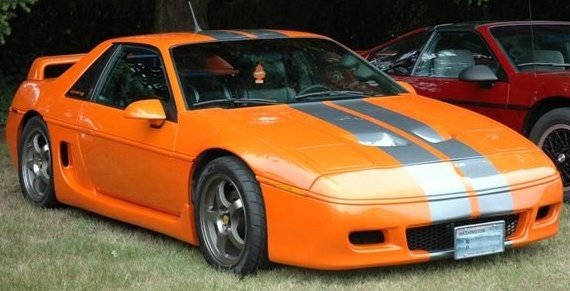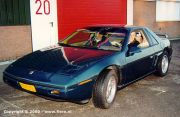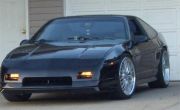|
|
Pontiac Fiero
The Pontiac Fiero is a mid-enginedsports car that was built by the Pontiac division of General Motors from 1984 to 1988. The Fiero—meaning "proud" in Italian and "wild", "fierce", or "ferocious" in Spanish—was designed by George Milidrag and Hulki Aldikacti as a Pontiac sports car. The Fiero was the first two-seater Pontiac since the 1926 to 1938 coupes, and also the first and only mass-produced mid-engine sports car by a U.S. manufacturer. Many technologies incorporated in the Fiero design such as plastic body panels were radical for its time. Alternative names considered for the car were Sprint, P3000, Pegasus, Fiamma, Sunfire, and Firebird XP.[citation needed] The Fiero 2M4 (2-seat, Mid-engine, 4-cylinder) was on Car and Driver magazine's Ten Best list for 1984. The 1984 Fiero was the Official Pace Car of the Indianapolis 500 for 1984, beating out the new 1984 Chevrolet Corvette for the honor. 370,168 Fieros were produced over the relatively short production run of five years; by comparison, 163,000 Toyota MR2s were sold in its first five years.[1] At the time, its reputation suffered from criticisms over performance, reliability and safety issues. Today however, compared to less adventurous attempts at two-seaters such as the Ford EXP, the unique style of the Fiero compared to other American cars has left it a cult following as a collectible car. It remains a popular chassis for rebodies and electric conversions.
HistoryAlready selling the Corvette, General Motors management and accountants were opposed to investing in a second two-seater sports car. But in 1979, during the oil crisis, management saw a market opportunity for a fuel-efficient sporty commuter car, and design work on the Fiero commenced. To this end, it was fitted with a fuel efficient version of GM's 2.5 L four-cylinder"Iron Duke" engine capable of 27 mpg-US (8.7 L/100 km; 32 mpg-imp) in the city and 40 mpg-US (5.9 L/100 km; 48 mpg-imp) on the highway with the economy-ratio transmission option. These figures are U.S. Environmental Protection Agency test-circuit results, published by Pontiac, and confirmed from multiple sources.[2] It was impressive mileage for a 2.5-liter engine of the period, and still good by today's standards, but the three-speed automatic reduced highway mileage to only 32 mpg-US (7.4 L/100 km; 38 mpg-imp). With respect to fuel economy, the Fiero would appeal to a market niche for which the Corvette with its V8 engine was unsuitable. A mid-engine layout was chosen as a way to reduce both aerodynamic drag and vehicle weight to improve fuel efficiency, and also for its handling, traction, and braking benefits. The sports car potential of the mid-engine layout was not fully realized when the Fiero debuted. In line with its market position, the tires, brakes, and some suspension components were carried over from other GM economy cars (like the Chevrolet Citation and Chevrolet Chevette) so the Fiero could be priced appropriately. As a result, the handling and cornering abilities of the initial Fiero were merely on par with other contemporary sporty coupes (Road & Track 1985). The public had high expectations for the Fiero with its mid-engine layout and futuristic styling, which resembles more exotic mid-engine sports cars costing much more. While initially garnering good reviews for its handling (Motor Trend 1984), the Fiero soon received disappointing reviews, as the automotive critics expected higher performance from a mid-engine two-seater. Despite the critical press, the Fiero sold extremely well and Pontiac operated three shifts at the factory during 1984, and could not keep up with initial demand.[3] The sharing of suspension components with other GM cars meant the rear suspension and powertrain was almost identical to that of the Chevrolet Citation and Pontiac Phoenix; the Fiero even included rear tie rod ends attached to a "steering knuckle", although these were hard-mounted to the engine cradle and only used for maintaining the rear tire alignment. The front suspension was derived from the Chevrolet Chevette, and Chevette enthusiasts found that they could upgrade their undersized front brakes and rotors using Fiero parts. By 1985, the oil crisis was a thing of the past and demand developed for a Fiero having more engine power and better sports car performance. Pontiac responded by introducing the GT model which included upgraded suspension tuning, wider tires, and a V6 engine having 43 horsepower (32 kW) more than the base four-cylinder. In 1986, the GT model was restyled to look even more sleek. Numerous changes were made to the 1988 Fiero. The most significant was a completely redesigned suspension (and parts of the space frame) to realize the potential of the mid-engine layout. Now unique to the Fiero, the new suspension included new two piece brake calipers and upgraded brake rotors for 1988.[4] The available I4 and V6 engines benefited from evolutionary improvements, but the planned availability of turbochargers and newer DOHC engines did not happen before production ended.
Production years
19841984 was the first production year for the Pontiac Fiero, beginning production in August 1983. In an effort to sell the car as being economically sensible, GM equipped and sold the Fiero as a commuter car; however, the marketing build up leading to initial release indicated anything but a regular commuter. The car also proved uncomfortable for some drivers because of the lack of power steering. 1984 was the only year in which the Limited "Indy Pace Car" edition, consisting of an Indianapolis 500-themed option package on SE-model vehicles, was offered (excepting 1985, in which the package was specially reissued). Approximately 2,000 of these vehicles were sold. The Indy had aero body cladding and new front and rear fascias that would be used on the 1985 GT. Only the underpowered four-cylinder engine was available, though a few prototypes could be seen driving around the Greater Detroit area with a unique periscope-style inlet sprouting from the engine compartment and curving up and over the roof.[citation needed] This "periscope" style inlet was used on the actual Indy Pace Car Fieros that appeared at the 1984 Indianapolis 500. This inlet scoop, and the 2.5-liter Super Duty engine that they fed, were not available on the production model pace car replicas. 19851985 saw the introduction of the GT model, which looked just like the 1984 Indy model without the decals or body color wheels. The problem with insufficient power was addressed, much to the satisfaction of the general public. A Chevrolet 2.8 L V6 engine rated at 140 hp (100 kW) and 160 ft·lb (220 N·m). was put into the car, satisfying most critics of the base engine. The High Output V6 was paired with a modified Muncie 4-speed transmission. The four-cylinder engine (known as the "Iron Duke") was now paired with the Japanese-designed Isuzu five-speed transmission (also produced at the Muncie, Indiana plant).
19861986 Fiero SE 2M6
1986 was the first year the fastback roofline was offered (sometimes wrongly referred to as a "1986½" model—there was only one "GT" in 1986). Though originally conceived by Pontiac insiders as a new model, possibly called the "GTP" or "GTU," it has been said that GM management at the time felt that using "GTP" or "GTU" suggested a racing car and thus an image they did not want to promote. Individuals present at the unveiling of the new fastback roof style at a GM test track actually thought it was a new Corvette at first. But this new body style simply became the GT model for 1986 while the old 1985 GT body style became the SE model. Also offered late in the production year was a five-speed Muncie-Getrag transmission (coupled only to the V6 engines). Models equipped with the four-cylinder engine remained largely unchanged. The clutch hydraulic systems were redesigned with new master and slave cylinders.
19871987 saw changes to the front and rear fascias on the "base coupe" with the SE & GT models keeping the same "Aero" nose. The new non-aero noses lost the black bumper chunks of the earlier models and had a smoother look. The four-cylinder engine's power rating increased to 98 hp (73 kW) with some major modifications which included a roller cam, redesigned intake manifold, distributorless ignition system [DIS], open combustion chamber cylinder head and upgraded throttle-body fuel injection system. This was the last year for the spin-on oil filter on the four-cylinder. The car was offered in Bright Metallic Blue and replacing the ribbed black molding was the round style found on the GT models. As a side note, the SE models retained the ribbed molding, and added the aero nose found on the GT. Redesigned headlight motors appeared in 1987. Additionally, starting with the 1987 model Pontiac dealerships offered an upgrade in the form of an "option" that changed the original body to a Ferrari-type body, called the Fiero Mera. While technically a "kit", the change in body style was offered only on new Fieros and is considered a class of car in its own right. There was a limited production of Fiero Meras made however, as the company that produced them, Corporate Concepts, was sued by Ferrari and ordered to stop.
1988 | |||||||||||||||||||||||||||||||||||||||||||||||||||||||||||||||||||||||||||||||||||||||||||||||||||||||||||||||||||||||||||||||
| This section does not cite any references or sources. Please help improve this section by adding citations to reliable sources. Unsourced material may be challenged and removed. (November 2009) |
Suspension design
The front end of the car is a wider direct derivative of the Chevrolet Chevette and Pontiac T1000. It employs a double A-arm (or double wishbone) design common prior to the advent of struts, and has naturally good geometry. A drawback of this design, however, means that the car's front suspension has four ball joints and four tie rod ends. Nevertheless, the tie-rods allow toe-in/out adjustability. Minimal camber adjustments exist on 1984 to 1987 models without an after-market upgrade available from MOOG that replaces the upper ball joints with slotted mounting points units. The joints have typical grease fittings for regular lubrication commonly found on pre-2000 autos.
The rear suspension is essentially a GM X-car's (Chevrolet Citation, Oldsmobile Omega and Pontiac Phoenix) front suspension moved to the rear of the Fiero. The uppers are top-plates and Chapman struts, while the lowers are attached with ball joints. In lieu of the steering rack which would have been installed in an X-car, tie rod ends are attached to the engine cradle and used to align the rear wheels.
The four-wheel independent suspension provides uncharacteristically accurate handling for a vehicle of its size and price range. However, due to the use of multiple suspension pivot and attachment points (similar to the Corvette's suspension architecture), maintaining the suspension is more costly than some less technical suspension systems.
With the 1988 model year came a completely new front and rear suspension with vented disc brakes at all four corners- what Pontiac's engineers had planned for the car to have from the beginning. The front suspension geometry was changed to decrease the scrub radius thus decreasing steering effort without adding a bulky power steering system. The camber curve was also much improved, the dampers are moved inside the coil springs, and new sealed bearing/hub units were used in 1988. The rear suspension featured multi-link (two lateral links and one trailing arm) Chapman strut suspension, and the tie-rod related bump steer experienced with the earlier suspension design was fixed. The brakes were also upgraded to 10.5 in (267 mm) vented rotors on the front and rear with an improved slide caliper design having larger diameter slides. The Fiero Formula (new for 1988) and Fiero GT models also received a rear anti-sway bar to compliment non-progressive rate springs.
The 1984–1987 frames will accept a 1988 rear cradle. However, the struts must be replaced with a narrower diameter Carrera coil-over unit with a steel tube extension and offset mounting plates added to replace the Chapman strut unit. Thus yielding a larger, 1984–1987 engine compartment with the ride-quality benefits of the 1988 suspension.
In the August 1985 issue of Road & Track, the Fiero was tested against six other sports cars. The slalom results (MPH): Honda Civic CRX Si: 62.5 Toyota MR2: 61.6 Pontiac Fiero: 61.5 Alfa Romeo Graduate: 58.4 Bertone X1/9: 58.3 Mazda RX-7 GSL: 57.2
Transmissions
Automatics
All automatic-equipped Fieros were equipped with the three-speed TH-125 with torque converter lockup. Automatic transmission final drive ratios:
-
- 1984–1986: 3.18 (RPO "F75")
- 1987–1988: 3.33 (RPO "GX3")
- TH-125 Gear Ratios
- 1st Gear: 2.84
- 2nd Gear: 1.60
- 3rd Gear: 1.00
- Reverse: 2.067
Four-speed manual
All 4-speed manual transmissions were built at the Muncie, IndianaAllison plant. The 1984 production line saw two transmissions, a performance 4-speed with a final drive ratio of 4.10, and an economy 4-speed with a final drive ratio of 3.32. The V6 on the 1985 model and part of the 1986 production year came with a 4-speed with a final drive ratio of 3.65. The lower-geared 4.10 4-speed transmission showed improved acceleration, but sacrificed fuel economy.
Five-speed manual
Isuzu and Muncie (Getrag)- 5-speed transmissions were available, depending on model and equipment beginning in 1985 for the Isuzu 5-speed which came on 4-cylinder cars and in 1986 for the Muncie 5-speed which came on V6 equipped cars. The Getrag 282 5-speed is sometimes referred to as the Muncie 282 or the Muncie Getrag 282, as the design was licensed to General Motors for manufacture by Muncie (Getrag never built the 282). This Muncie transmission is the stronger unit, designed for use with the higher output of the V6.
Manual transmission gear ratios
| Year | Style | Code | Axle | 1st | 2nd | 3rd | 4th | 5th | rev. |
|---|---|---|---|---|---|---|---|---|---|
| 1984 | econo 4-speed | MY8 | 3.32 | 3.69 | 1.95 | 1.24 | 0.73 | — | 3.42 |
| 1984 | perf 4-speed | M19 | 4.10 | 3.53 | 1.95 | 1.24 | 0.81 | — | 3.42 |
| 1985 | V6/4-speed | M17 | 3.65 | 3.31 | 1.95 | 1.24 | 0.81 | — | 3.42 |
| 1985 | I4/5-speed | MT2 | 3.35 | 3.73 | 2.04 | 1.45 | 1.03 | 0.74 | 3.50 |
| 1986 | V6 4-speed | M17 | 3.65 | 3.31 | 1.95 | 1.24 | 0.81 | — | 3.42 |
| 1986 | V6 5-speed | MG2 | 3.61 | 3.50 | 2.05 | 1.38 | 0.94 | 0.72 | 3.41 |
| 1988 | I4/5-speed | MT2 | 3.35 | 3.73 | 2.04 | 1.45 | 1.03 | 0.74 | 3.50 |
| 1988 | V6/5-speed | MG2 | 3.61 | 3.50 | 2.05 | 1.38 | 0.94 | 0.72 | 3.41 |
The Fiero's technologically advanced spaceframe technology went on to be incorporated in the Saturn S-series, Pontiac Transport and Chevrolet Lumina APV carlines.








